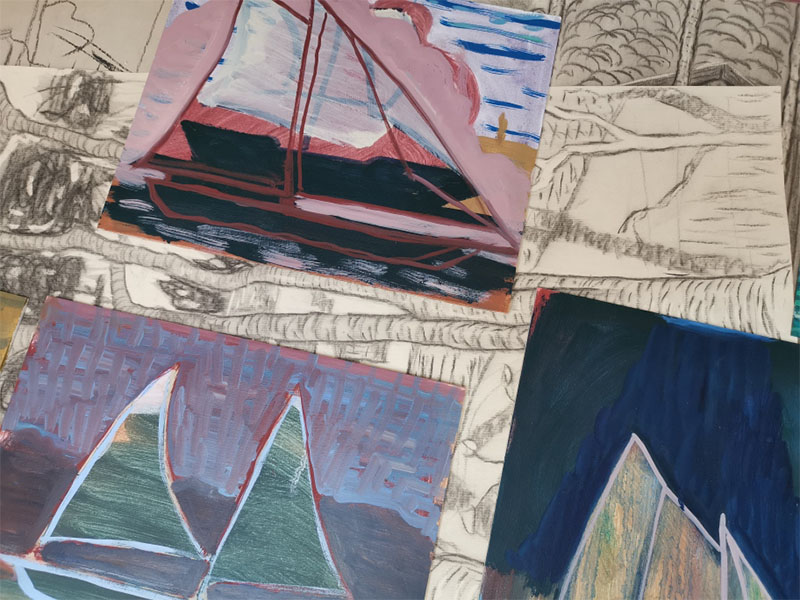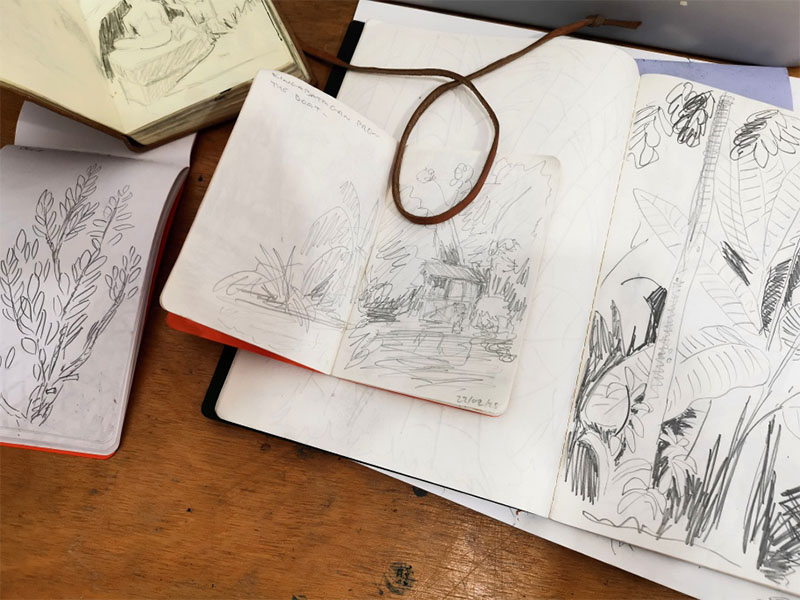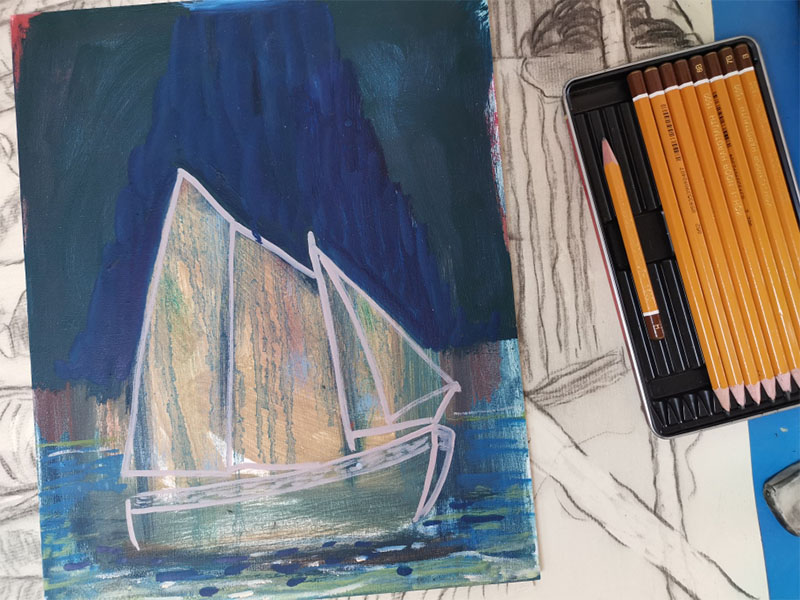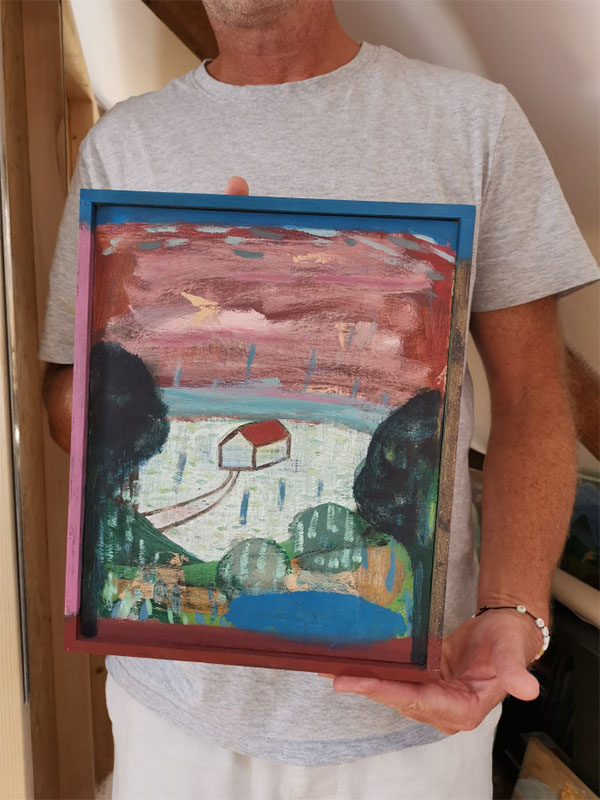Tell us a little about your practice
I’m a studio-based painter. I make paintings, drawings, sometimes assemblages or maquettes all rooted in thinking about painting itself — how it’s made, what it is, and why we do it. I’m also interested in where painters work, past and present, and how that influences the process. It often ends up feeling like a kind of imagined history of painting.

How do you build a body of work?
I like to work on several things at once; a dozen or so paintings of various sizes are generally strewn around the studio. In the last four or five years, large drawings have also come into view. I generally have various bits of assemblage on the go as a kind of distraction. I’m process-led, and that process is very intuitive. As things develop, ideas and narratives begin to form as to what each work may be about. When several works reach a certain point, natural groupings or themes begin to form. There’s a lot of back and forth and bouncing ideas around between the different media.
Where do you take inspiration from?
Painting essentially. Technical things, formal and conceptual ideas relating to painting, the lives of painters, the history of the subject, and how I feel about all of that in my studio at any given moment. It’s a very deep and multifaceted well to draw from.
How do you develop your ideas?
Ideas develop through making. When I’m working I’m focused, for the most part, on formal matters; how elements are arranged on the surface, for example. At some point in the process, I feel an urge to describe for myself what I’m seeing, I get a feeling that something is happening, a presence emerging perhaps. The outcomes are often difficult to describe satisfactorily, and so, I’ve come to rely heavily on analogy, simile and metaphor. These occasionally find their way out of the paintings, which then develop in different directions through drawing and other modes of making. I try not to analyse too much, but it does seem very cyclical; one thing informs the former or the latter, back and forth, until things coalesce.

What are the highlights of your career so far?
My show "The Paint Club" in the Picture Room at Newlyn Art Gallery, and being awarded funding by the Arts Council to produce an accompanying book. A lot of interesting happenings and connections occurred as a result, but in reality, any opportunity to show work and connect with audiences and fellow artists is a privilege. Also, being involved with the Newlyn School of Art certainly made my Mum very happy!
How would you describe the Defining Practice programme at Newlyn School of Art?
It's a chance for students to begin to understand how and why artworks can be made. What the process looks and feels like. The beginning of an ongoing dialogue, and the development of a toolkit that will accompany them throughout their artistic endeavours.
There is no ‘House Style’ at Newlyn School of Art, and together with a host of excellent tutors and specialists, students develop a personal approach to art-making.
Do you have any advise for prospective students?
A lot of people come to courses saying, ‘I don't know what my thing is.’ I’m a big believer in not worrying about that. You will find out what your thing is by making the work. You just have to keep going: putting the paint on, taking it off; manipulating the stuff; taking photographs, reading widely, being observant, listening carefully – and then things gradually start to crystallise through the making.
Everyone thinks that they need to arrive with an idea, thinking it should be about this one specific thing, but actually on a practical level it’s much more domestic. It’s not about grand narratives and big gestures; it’s about the small things that you do and the accumulative effect of that. That’s what I’m hoping I can introduce in Defining Practice. And hopefully that persistence of just making work, no matter what the outcome, will serve the participants well if they go on to join Studio Practice or simply continue in their own way.

How are the sessions in Defining Practice broken down?
Each session introduces a different approach or way of thinking about a certain subject, alongside exploring materials and processes.
The students benefit from access to a broad range of surfaces, paints and drawing materials, and practical guidance on how to use them. Students will also be introduced to various concepts, artists and ways of thinking about how and why artists operate.
We want to arm students with a range of ways to think through the use of materials, to think while making and doing. That’s a transferable skill which can be equally applied to performance or three-dimensional work, for example. We aren’t going to teach anybody how to paint or draw; it's more about considering ideas in a broader context.
We have to give ourselves permission to experiment, and to accept, enjoy and learn from any perceived ‘failures’ as part of the process. This is where our ongoing conversations throughout the course are so valuable. We are going to work and talk, and each student will have a one-to-one tutorial during each session to discuss where they have been and what they might explore next.
What do you enjoy most about teaching?
Honestly, I enjoy discovering things along with the students and learning from other tutors. It’s a shared experience of lifelong learning.

Daniel Turner was interviewed by Kari Herbert. The next cohort for Defining Practice begins in October 2025. To speak with one of our lead tutors and to apply click here.
Portrait by Chris Frazer Smith